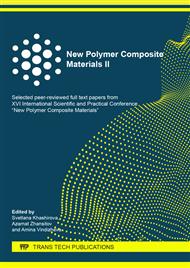[1]
N.T. Kakhramanov, G.Sh. Kasumova, V.S. Osipchik, R.Sh. Gadzhieva, Wear resistant polymer materials, Structure and properties, Plastics. 11-12 (2017) 8-15.
Google Scholar
[2]
V.N. Vodyakov, E.A. Radaykina, A.V. Kotin, New polyamide composites for friction power cylinders of agricultural machinery, Key engineering materials. 816 (2019) 157-161.
DOI: 10.4028/www.scientific.net/kem.816.157
Google Scholar
[3]
N.I. Baurova, V.A. Zorin, The use of polymer composite materials in mechanical engineering, INFRA-M, Moscow, 2018.
Google Scholar
[4]
E.L. Kalinichev, M.B. Sakovtseva, Properties and processing of thermoplastics, Chemistry, Leningrad, (1983).
Google Scholar
[5]
Z. Tadmore, K. Gogos, Theoretical foundations of polymer processing, Chemistry, Moscow, (1984).
Google Scholar
[6]
Chang Day Han, Rheology in polymer processing processes, Khimiya, Moscow, (1979).
Google Scholar
[7]
I.A. Barvinsky, I.E. Barvinsky, Problems of injection molding of products from PM: unstable filling of the mold, Pol. materials. 8 (2009) 14-21.
Google Scholar
[8]
R. Reinicke, F. Haupert, K. Friedrich, On the tribological behaviour of selected, injection moulded thermoplastic composites, Composites Part A: Applied Science and Manufacturing. 29 (1998) 763-771.
DOI: 10.1016/s1359-835x(98)00052-9
Google Scholar
[9]
C.-T. Huang, H.-C. Tseng, Simulation prediction of the fiber breakage history in regular and barrier structure screws in injection molding, Polymer Eng. Sci. 58 (2017) 452-459.
DOI: 10.1002/pen.24660
Google Scholar
[10]
H.-C. Tseng, R.-Y. Chang, C.-H. Hsu, Predictions of fiber concentration in injection molding simulation of fiber-reinforced composites, J. Thermopl. Compos. Mater. 31 (2018) 1529-1544.
DOI: 10.1177/0892705717738302
Google Scholar
[11]
A. Arabpour, A. Shockravi, H. Rezania, R. Farahati, Investigation of anticorrosive properties of novel silane-functionalized polyamide/GO nanocomposite as steel coatings, Surfaces and Interfaces. 18 (2020) 100453.
DOI: 10.1016/j.surfin.2020.100453
Google Scholar
[12]
W. Michaeli, C. Starke, Ultrasonic investigations of the thermoplastics injection moulding process, Polymer Testing. 24 (2005) 205-209.
DOI: 10.1016/j.polymertesting.2004.08.009
Google Scholar
[13]
E.I. Radaykina, V.N. Vodyakov, A.M. Kuzmin, V.V. Kuznetsov, Antifriction polymer composition, Patent RF № 2688517 (2019).
Google Scholar
[14]
S.I. Wolfson, Dynamically vulcanized thermoplastic elastomers: production, processing, properties, Nauka, Moscow, (2004).
Google Scholar


